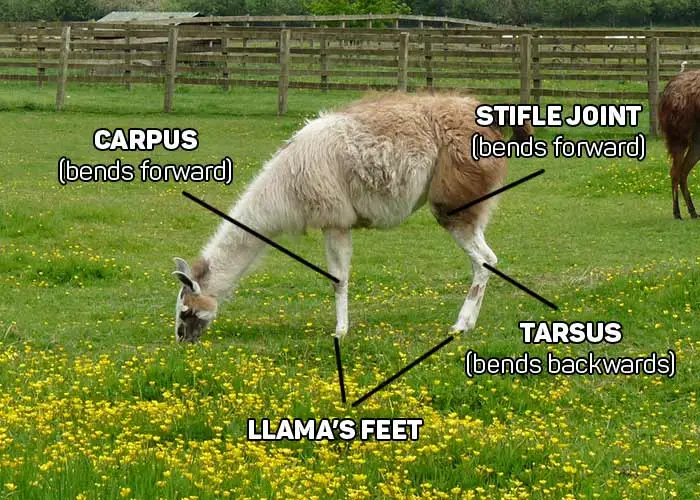Llamas have four legs and one foot at the end of each leg. The legs are long, elegant, and very mobile. They allow llamas to walk easily, run fast, jump high (up to 3 ft 8.5 in), and make sharp turns to outrun and escape predators.
Pedro Cieza de León, a 16th-century Spanish conquistador and chronicler of Peru, described llamas as “as large as small donkeys with long legs”.
Llamas inherited this trait from their long-limbed ancestors called Hemiauchenia. These animals migrated from North America to South America 3 million years ago and evolved into South American camelids; one of them being llamas.
Llamas belong to the taxonomic order Artiodactyla – this means that llamas walk on two of their five toes, the third and fourth.
Llamas also belong to the suborder Tylopoda – this means that instead of having hooves, llamas walk on their padded feet.

Table of Contents
What Do Llama’s Legs Look Like?
Llama’s legs are slim and elongated limbs that allow the animal to walk properly. The front legs are shorter than the back legs. Llamas have several joints in their legs similar to human knees and wrists.
At the bottom of each leg, there’s the foot. Each foot has two toes, cushioned leathery pads on the bottom, and thick nails at each end. These pads allow llamas to better feel the ground they walk on which is very helpful in rocky, mountainous terrains.

The bones of the llama’s front leg include:
- Scapula
- Humerus
- Sternum
- Radius
- Carpal bones
- Cannon bone
- Phalanges
Llama’s back leg bones include:
- Pelvis
- Femur
- Patella
- Tibia
- Tarsal bones
- Cannon bone
- Phalanges
What makes llama’s legs unique are its joints.

On their back legs, llamas have a stifle joint. It is similar to a human knee, and it bends forward.
Below the stifle joint, llamas have a tarsus. It is a joint similar to a human ankle and bends in the opposite direction to a human knee.
On their front legs, llamas have a joint similar to a human wrist. It is called carpus, and you can look at it as a human knee.
Llamas have such legs and joints because it allows them to stay, rest, or sleep in a kushed position for hours. Kushed position or sternal recumbency is when llamas tuck their legs underneath their body.
The position looks like this.

Llamas also have thick calluses on their chest and knees.
How Long Are Llama’s Legs?
Llamas have legs between 30.5 and 37 inches (77.5-94 cm) long. The front legs are shorter than the back ones and have a length of 30.5 inches (77.5 cm). The back legs are about 37 inches (94 cm) long.
Compared to alpacas, llamas have a lot longer legs. Alpacas have around 22.3 inches (56.6 cm) long front, and around 26.7 inches (68 cm) long back legs.
Compared to horses, llamas have shorter legs. A horse has around 50 inches (126 cm) long front legs, and about 55 inches long (138.5 cm) back legs.
Llama babies (crias) also have incredibly long legs and can stand on their feet and walk within 30-40 minutes.
Here’s how llamas compare to other mammals when it comes to average leg length.
| Animal | Front leg length | Back leg length |
| Llama | 30.5 in | 37 in |
| Alpaca | 22.3 in | 26.7 in |
| Horse | 50 in | 55 in |
| Camel | 59 in | 63.3 in |
Why Do Llamas Have Long Legs?

Llamas have long legs to reach higher trees and vegetation more easily, spot incoming predators and alarm others, and communicate with other members of their herd.
Llamas have very long necks, around 24 inches (60 cm). Such necks in combination with long legs allow llamas to reach vegetation that is over 6 feet in the air (1.8 m).
Of course, due to such heights, llamas can spot a coyote trying to steal their sheep or a goat. They will then charge at the intruder to protect their flock.
When they spotting a larger predator they can’t overcome, llamas use their long legs as their primary means of defense – they try to run away from danger.
And how might llamas communicate with their legs, you might ask?
Llamas have special scent glands on the outer surfaces of their back legs. These parts of the legs are usually hairless and referred to as “chestnuts.” These glands secrete pheromones which scientists think function as an alarm when the animal is frightened.
Llamas also have another scent gland on the inner surface of the back legs. This gland emits a smell that helps animals within the same herd identify one another.
Male llamas will often bite one another’s legs while fighting for dominance, as well as the legs of females to encourage them to lie down for breeding.
A small fun fact: llamas are explosive and agile animals that have extremely strong leg muscles that allow them to jump extremely high. The world record for the highest llama jump is an incredible 3 ft 8.5 in ( 1.13 m).
Are Llamas Digitigrade And How Do They Walk?
Llamas are digitigrade animals. This means that they walk on their toes without touching the ground. Their bones of the wrist, palm, ankle, and sole are raised from the ground, and llamas walk or run by putting two of their digits on the ground.
When they walk, llamas move ipsilateral pairs of legs together. This means that the llama moves the legs of the same side of the body forward at the same time, and then the legs of the other side.
Such a way of walking prevents the fore and hind legs on the same side from hitting one another when a llama is running. This allows it to have a longer stride length, and move faster and more efficiently than animals that trot.
A llama carries around 67% of the weight on its front legs and only 33% on the back legs.
Llama Leg Diseases And Examination

Just as with humans, you should regularly check the health of your llama with a routine physical examination. This will help you feel what the legs of a healthy llama look and feel like, but will also familiarize llama with being examined.
Everyday observations and routine checks every 6-8 weeks is what veterinarians recommend.
An injured llama might limp while walking or avoid putting weight on one of its limbs. You should check that the leg joints and shoulders are not swollen, tender, or warmer than the rest of the body.
Make sure to check that the llama is not in pain while walking and moving its joints. A healthy llama should not make cracking or crunching sounds while walking. It should distribute its weight properly on all of the legs – if not, that might be an indication of a problem.
When they get in a fight, one male llama might bite the legs of another llama and create wounds and lacerations.
If not treated, this might lead to inflammation of the joint, and later to arthritis. Joint inflammation and arthritis are also common in older llamas.
Llamas might have different limb deformities such as crooked legs, arthrogryposis, shortening of long bones, luxation of the patella, and many others.
Shatter fractures, dog bites, other severe lacerations, inoperable tumors, nonresponsive osteomyelitis, or vascular lesions might result in gangrene of the distal limb. This irreparable trauma to the legs can’t be treated and might require amputation.
In a healthy llama, the limbs should be positioned closer to the midline than they are in most other domestic animals.
Feeling down? Here are 25+ funny llama memes to brighten your day!
Final Thoughts
This concludes our article on llama legs. Here we described all four legs of llamas, gave their dimensions, and explained how long they are compared to horses, alpacas, and camels.
We also explained how llamas walk and some injuries and defects of the legs llamas might have.
References:
[1] Van der Sluijs, Leendert, M. Gerken, and H. Preuschoft. “Comparative analysis of walking gaits in South American camelids.” Journal of Zoology 282.4 (2010): 291-299.
[2] Guinness World Records, www.guinnessworldrecords.com
[3] Fowler, Murray. Medicine and surgery of camelids. John Wiley & Sons, 2011.